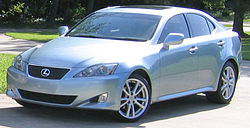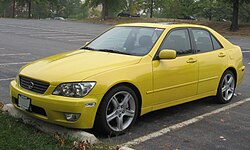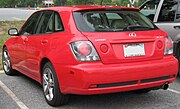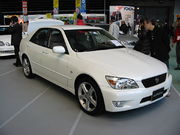| Lexus IS | |
|---|---|
| Manufacturer | Lexus |
| Parent company | Toyota Motor Corporation |
| Production | 1998–present |
| Assembly | Tahara, Aichi, Japan Kyūshū, Japan |
| Class | Entry-level luxury car/Compact executive car |
| Layout | Front engine, rear-wheel drive / four-wheel drive |
| Platform | S-Series |
| Related | Lexus GS |
The Lexus IS is a series of entry-level luxury cars/compact executive cars produced by the Lexus marque of Toyota Motor Corporation. The IS was introduced as an entry-level sport model slotted below the ES in the Lexus lineup and competing against the BMW 3 Series, Mercedes-Benz C-Class and Nissan Skyline/Infiniti G35 sports sedans. The IS was originally sold as the Toyota Altezza in Japan until the introduction of the second generation Lexus IS design. The Altezza name is still used at times to depict chromed car taillights like those fitted to the first generation model.
The first generation Altezza (codename XE10) was launched in Japan in October 1998, while the Lexus IS 200 (JCE10) made its debut in Europe in 1999 and in North America as the IS 300 in 2000. The first generation, I6-powered IS featured sedan and wagon variants. The second generation IS (GSE20) was launched globally in 2006 with V6-powered IS 250 and IS 350 sedan models. A high-performance V8 version, the IS-F, premiered in 2007. According to Lexus, the IS designation stands for Intelligent Sport.
First generation
| First generation | |
|---|---|
| Also called | Lexus IS 200 Lexus IS 300 Toyota Altezza |
| Production | 1998–2005 |
| Body style(s) | 4–door sedan 5–door hatchback/station wagon |
| Engine(s) | 2.0 L 1G-FE I6 (AS200) 2.0 L 3S-GE I4 (RS200) 3.0 L 2JZ-GE I6 (AS300) |
| Transmission(s) | 4–speed automatic 5–speed manual 5–speed automatic 6-speed manual |
| Wheelbase | 2670 mm (105.10 in) |
| Length | Sedan: 4400 mm (173.2 in) SportCross: 4415 mm (173.8 in) |
| Width | 2004-05: 1725 mm (67.90 in) 2004-05: 1720 mm (67.70 in) |
| Height | 1410 mm (55.50 in) 1440 mm (56.7 in) |
| Curb weight | 1510 kg (IS 200) |
Produced as a direct competitor to the luxury sport sedans of the leading European luxury marques, the Altezza/IS was designed with a greater performance emphasis than typically seen on prior Japanese luxury vehicles. The design received critical acclaim at its 1998 launch, and was awarded Japan's "Car of the Year" honor for 1998-1999. A year later, Lexus began marketing the IS equivalent models in Europe, and the IS debuted in the U.S. as a 2001 model.
The Altezza came in 3 variants:
- The AS200 (Chassis code TA-SXE-10, sedan or TA-GXE-10 FR Gita wagon, TA-GXE-15, 4WD Gita wagon), powered by a 1G-FE inline-6 engine generating 160 PS JIS (118 kW) or 155 PS DIN (114 kW) and mated to a 6–speed manual transmission (4–speed automatic optional)
- The RS200 (Chassis code GH-SXE-10, sedan) powered by a Yamaha tuned 3S-GE inline-4 engine generating 210 PS JIS (154 kW) and mated to a 6–speed transmission (5–speed automatic optional)
- The AS300 (Chassis code TA-JCE-10 FR Gita Wagon, or TA-JCE-15, 4WD Gita wagon) powered by a 2JZ-GE inline-6 engine generating 220 PS JIS (162 kW) or 215 hp SAE (160 kW) and mated to only a 5–speed automatic for the FR Gita Wagon or a 4–speed automatic for the 4WD Gita Wagon.
Lexus IS vehicles sold in North America, as well as the Japanese hatchback/station wagon version called the Gita (called Lexus IS SportCross in the U.S. and Europe) were only available in the 3.0 liter 6-cylinder version (2JZ-GE). In the U.S. market, sales fell below expectations; after hitting a high of 22,486 units in 2001, IS sales dropped below the 10,000-unit mark in 2004. The IS 200 fared better in Europe and Asia, but still fell well short of the sales volume achieved by the Mercedes-Benz C-Class and other, mostly German-made competitors. This trend was indicative of Lexus' smaller global status; while Lexus' range of cars is very successful in North America, the marque's sales still lag behind its German rivals in Europe and several other markets. In Europe the IS 300 was only available with the 5-speed automatic transmission; the lack of a manual gearbox option may have limited sales in contrast to its rivals, the BMW 3-Series and the Mercedes C-Class.
The IS 200/300 interior featured unique elements not typically found in other Lexus models. These included a chrome metal ball shifter, pop-up navigation screen, and chronograph-styled instrument panel (with mini gauges for temperature, fuel economy, and volts). The styling cues of the rear light clusters on the first generation Lexus IS were copied by a number of after-market accessory manufacturers for applications on other vehicles. This iconic style of one or more internal lamp units, covered with a clear (or tinted) perspex cover made popular by Lexus, became known in many circles as 'Lexus-style' or 'Altezza lights'.
Visually the exterior of the European IS 200 Sport and 300 saloon were almost identical, the only differences being the boot insignia and the larger engined model having clear front indicators. Inside the IS 300 gained full leather seats rather than the leather/ecsaine of the 200, plus auto-dimming rear view and side mirrors, plus HID headlamps.
The EPA listed the first generation IS as a subcompact car. Although it technically had enough overall volume to be called a compact, rear seat room exhibited subcompact dimensions.
The engineering work was led by Nobuaki Katayama, who was responsible for the AE86 project.
Tuning
The 2JZ-GE powered IS series are popular amongst tuners in the U.S. because of their 6-cylinder engines. The Altezza is mostly popular amongst tuners not only because of its possible engine swap for the previous generation Toyota Supra's 2JZ-GTE motor, but as it is viewed as the successor to the AE86. Modified versions of the 2JZ-GTE have been seen with over 750 kW (1000 hp).
In Japan, the RS200 has a wide availability of tuning parts, the engine block is similar to the last of the SW20 MR2 and ST202 Celica but offers an upgraded Dual VVT-i. As a result, a number of tuning companies have modified the IS/Altezza over the years.
TTE converted an IS 200 first, and within a few years RMM in the US converted an IS 300. The MillenWorks-built Lexus IS 430 was unveiled at the 2003 SEMA Show in Las Vegas, Nevada. The IS 430 prototype is an IS 300 fitted with a 4.3 L V8 from the Lexus GS. Lexus dubbed the IS 430 a one-off with no plans for production. In Europe, Toyota Team Europe (TTE) shoehorned a supercharged 4.3 L V8 into an IS 300 bodyshell, the result is a 405 PS ECE (298 kW) sedan capable of accelerating from 0-100 km/h in 4.5 seconds. TTE also produced an aftermarket supercharger kit for the IS 200, raising the power output to 204 ps ECE (150 kw).
At the mean time, a number of Japanese tuning firms, HKS, Blitz, Top Secret, Sard, Power Enterprise, including Toyota's own TRD, started to develop plenty of performance parts, typically from super chargers, turbo chargers, and even individual throttle bodies, and sometimes complete car conversions.
The RS200 is also used by many racing teams, including TRD (Toyota Racing Development), to race in various touring car racing series across Asia. A Lexus IS 200, based on a heavily modified RS200, has also raced in the British Touring Car Championship with limited success.
Second generation
| Second generation | |
|---|---|
| Production | 2006–present |
| Body style(s) | 4–door sedan |
| Engine(s) | 2.2 L diesel 2AD-FHV I4 (IS 220d) 2.5 L 4GR-FSE V6 (IS 250) 3.0 L 3GR-FE V6 (IS 300) 3.5 L 2GR-FSE V6 (IS 350) |
| Transmission(s) | 6–speed manual 6–speed automatic |
| Wheelbase | 2730 mm (107.50 in) |
| Length | 4575 mm (180.10 in) |
| Width | 1800 mm (70.90 in) |
| Height | RWD: 1425 mm (56.10 in) AWD: 1440 mm (56.7 in) |
| Curb weight | 1570 kg (IS 250) |
The IS was completely redesigned for the 2006 model year and was introduced in the fall of 2005. The Toyota Altezza name ceased to be used with the introduction of the Lexus name in Japan. A pre-production car of the second generation IS model was shown in the 2005 Geneva Auto Show. The slow-selling SportCross station wagon version was dropped from the lineup worldwide.
The new IS was the second debut of Lexus' new L-finesse design philosophy on a production vehicle, following the premiere of the 2006 Lexus GS performance sedan. The new IS design featured sleeker, coupe-like contours, a fastback profile, and a repeated arrowhead motif in the front fascia and side windows. The forward design was reminiscent of the earlier Lexus LF-C coupe concept. The second generation IS made its North American debut at the 2005 New York International Auto Show.
For Japan, the United States and Canada, three IS models are sold by Lexus:
- IS 250 - 2.5 L V6, 204 hp (152 kW), rear wheel drive
- IS 250 AWD - 2.5 L 4GR-FSE V6 with all wheel drive, 204 hp (152 kW) (Not offered in Japan)
- IS 350 - 3.5 L 2GR-FSE V6, 306 hp (228 kW), rear wheel drive
In the United Kingdom and parts of Europe, two IS models are sold by Lexus:
- IS 250 - 2.5 L V6, 204 hp (152 kW), rear wheel drive
- IS 220d - 2.2 L Inline-4, 175 hp (130 kW), diesel engine, rear wheel drive, manual transmission only
The IS 250 is available in Australia, New Zealand, Thailand, Singapore, Hong Kong (Automatic only), Taiwan, South Africa and South Korea. For China, Brunei, and Middle East markets, one model, the IS 300, with a 3.0 L 3GR-FE V6 engine (without gasoline direct injection), 228 hp (170 kW), and rear wheel drive, is sold. The diesel-powered IS 220d is only available in Europe.
The IS 250 RWD comes standard with a 6–speed manual transmission, and a 6–speed automatic transmission is available as an option. The IS 250 AWD, the IS 300, and the IS 350 are only available with the 6–speed automatic.
Compared to the first generation IS model, the second generation IS sedans offer a more typical Lexus interior with a focus on luxurious accoutrements. The interior features leather seats, lightsaber-like electroluminescent dash display lighting, and the choice of metallic or Bird's Eye Maple wood trim. Lexus SmartAccess keyless entry with push-button start is a standard feature. A high-resolution touchscreen navigation system, Bluetooth, a backup camera, and a Mark Levinson premium sound system with 14 speakers are available options. Other available features include a moonroof, power rear sunshade, and parking sensors. A precrash system is the first offered in the entry-luxury performance sedan market segment.
The IS 350's performance was praised in the February 2007 Road & Track Japanese luxury sports sedan comparison, in which the IS took first place and clocked a 0-60 mph time of 4.9 seconds. Citing independent testing by auto research firm AMCI, Lexus highlighted the IS' acceleration as the "fastest in its class."Some say this marks Lexus' first foray into the sport compact market that compares fairly well with its German competitors. However, prevailing criticisms are that its steering is not as communicative as that of the BMW 3 Series, the rear seat legroom (while improved over the first generation) is still tight, and that the higher-performance IS 350 is only offered with an automatic transmission. In response to criticism regarding the lack of a stability/traction control disable switch on 2006 IS models, Lexus added a VDIM/VSC off switch for the 2007 model year.
For 2006 IS models, the stability control system/traction control system can be disabled through non-conventional methods by using a code during engine start. This involves starting the car with the parking brake engaged, releasing the parking brake, pushing the brake pedal twice, holding it on the second push, engaging the parking brake twice, holding it on the second, and repeating until the vehicle traction light appears on the dash. This will effectively disable the system until the car is turned off.
In the 2007 IS models, in addition to the on/off switch for the traction-control system, Lexus added a roof-mounted shark-fin antenna. A new "X-Package" added a sport tuned suspension, special 18-inch alloy five-spoke wheels, illuminated scuff plates, and a front lip spoiler.
The introduction of the second generation IS model marked a resurgence in sales, with a 332% increase overall in 2006 compared to the previous year. In its first year of sales, the IS sold over 49,000 units, making it one of the ten best-selling luxury cars in the U.S. Abroad, the Lexus IS spearheaded Lexus' growing sales efforts in Europe, Australia, and South Africa, becoming the best-selling model in Lexus' lineup in many of the aforementioned markets.
Tuning
The second generation IS already has a variety of tuning parts from famous Japanese tuning companies. Although the new IS has only been on the market for a short period of time, there are already a number of body kits for it, showing the high demand for aftermarket tuning parts. In 2007, the Japanese TOM'S aftermarket tuning firm produced a modified IS 350 with a revised ECU, new air filter, modified exhaust, and additional available performance enhancements ranging from suspension to brakes. There are currently no compatible turbochargers for the IS250/350. Superchargers however, are available by companies LMS, and TOM'S producing close to 400 horsepower or more. The pending release of the 2008 Lexus IS-F will feature the debut of the first production-sanctioned racing modifications to the second generation IS design. In 2007, Lexus announced a Project Vehicle Program for that year's SEMA show, centered around the high-performance IS-F model. Lexus invited SEMA manufacturer members to submit their project Lexus vehicles for its show exhibition. It was the first time that the manufacturer had a formal presence at the aftermarket convention.
IS-F
In 2006, several automotive publications reported on rumors of a higher performance variant of the IS being tested at various stages of development. Spy photos of such a vehicle being tested in Germany and California were published in several magazines and websites. Among these spy reports, several photos were shown of a heavily modified and camouflaged IS sedan at the Nürburgring test track in Germany along with other disguised Lexus test vehicles. The previous generation IS 430 prototype vehicle was indicative of future possibilities for the IS series, including the likelihood that a second generation high-performance IS model could come equipped with a V8 engine. It was rumored that there would be a coupe and a convertible version for a 2009 model, as well as a convertible version of the V8-powered IS.
On 6 December 2006, Lexus officially confirmed the existence of the vehicle which they called IS-F in the press release.The IS-F sedan premiered at the 2007 North American International Auto Show on 8 January 2007 as the launch product of Lexus' F-Sport lineup of performance-focused vehicles.The new IS-F features a 5.0 L direct-injected V8 producing 416 SAE hp (423 PS, 311 kW) at 6,600 rpm, while peak torque is 371 lb-ft (505 Nm) at 5,200 rpm.The engine also features a two-stage intake system, engine oil and transmission fluid coolers and an oil pump designed for high-speed cornering. Images were leaked a couple of hours before the official announcement.
At its press debut, Lexus revealed that a separate "skunk works" team designed the IS-F in a manner distinct from typical Lexus engineering efforts. The IS-F promises 0-100 km/h (0-62 mph) acceleration under 4.9 seconds.The vehicle featured an 8-speed automatic transmission with sequential shift, a new sport version of Lexus' electronic stability control system (Vehicle Dynamics Integrated Management, or VDIM, featuring three distinct on-off modes), and was equipped with Brembo brakes stamped with the Lexus emblem. Other design features included a four-passenger cabin with carbon-fiber panels, steering wheel paddle shifters, and 19-inch BBS forged aluminum alloy wheels. The vehicle body was lowered by 1 cm (0.5 inches) compared to the standard IS. Noticeable about the IS-F's design are its quad exhaust tailpipes comprised of vertically stacked dual exhaust pipes on the left and right rear.
In October 2007, the IS-F premiered in Japan, with a 500-unit yearly target for that country, and a 5,000-6,000 yearly unit target for the U.S. market. Top speed was listed at 168 mph. An earlier Autoweek item had speculated that Lexus may build only 1,000 IS-Fs for the US market, and also suggested that the vehicle would have a top speed of 320 km/h (200 mph) (contradicting the generally accepted standard for this automotive class), which led automotive news sites to question the accuracy of their information.The editor and representatives of a major Lexus IS enthusiast website with Lexus press access further suggested that Autoweek's report may be referring to the LF-A supercar, which Lexus did indicate could reach 200 mph. In 2007, the head of Lexus GB stated in an interview that 150 IS-Fs would be allocated for the UK market.











![Validate my RSS feed [Valid RSS]](valid-rss-rogers.png)















































































ไม่มีความคิดเห็น:
แสดงความคิดเห็น